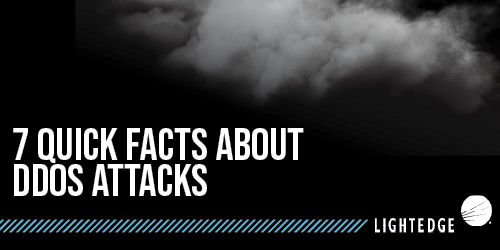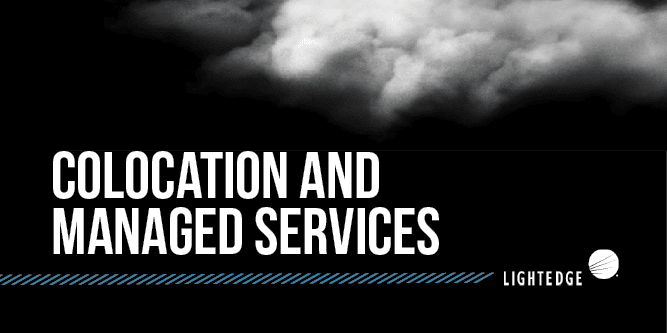The Forecast for 2019 Cloud Computing: 5 Predictions to Start Off the New Year
January 10, 2019

Lightedge
Author

The new year is moving full speed ahead, so it is time to predict where the cloud is headed in 2019. Many businesses rely on the cloud as a vital part of their enterprise infrastructure. The benefits of having a database that is easily accessible from any location has dramatically improved productivity across the workforce.
In the past, many companies have been apprehensive to migrate to the cloud. Luckily, more and more businesses have made the leap to cloud computing and act as a great example. With security being a major concern, new advances over the past couple of years have vastly reduced the number of successful breaches. The forecast for 2019 predicts continued advancement in secure clouds.
1. Cloud Migration Hits the Accelerator in 2019
2019 will be the year that enterprises hit the accelerator on their cloud migrations. Last year, we witnessed companies slowly but surely migrating their workloads to the cloud. This year, we expect that companies will fast-track their plans to migrate workloads to the cloud.
In the past couple of years, many enterprises have tested the waters by slowly moving workloads to the cloud. Now that these companies have experienced the benefits of cloud computing for themselves, 2019 will be the year of major cloud migration.
The insights and findings from LogicMonitor’s Cloud Vision 2020: The Future of the Cloud Study, predicts that 83 percent of enterprise workloads will be in the cloud by next year. The survey also shows the adoption of multiple cloud solutions. The prediction is that 41 percent of workloads will reside on public cloud platforms (Microsoft, Azure, Google, and others). An additional 20 percent are predicted to run on the private cloud followed by 22 percent running on hybrid cloud platforms.
With cloud migration on the fast track, having a strategy in place that will make company goals doable is imperative. Here is a quick low-risk checklist to ensure your cloud migration strategy stays on track in 2019.
Create an Organizational Transformation Plan
The first step is to communicate to everyone in IT what changes will occur, why they are changing, and when the changes will occur. This can be a sensitive topic, but it is the first requirement that must be completed in the cloud migration checklist. Otherwise, the migration will be chaotic, and progress will be slowed.
Many teams define migration problems at a situational level. It is crucial to put the migration plan in a holistic context. Leaders can resolve organizational problems by rethinking the architecture and structure.
It starts by recognizing that cloud migrations are less about strategy, application, and technology challenges, and more about and organizational structure and planning. As a CIO or leader in the company’s cloud migration plan, it is your job to define who, what, and when for each role.
Understand your Workload Priorities
Based on the progress made in 2018, choose workloads and data that you plan to migrate based on their fit with your selected cloud solution. Things to consider during this mapping period include, security, agility, and technical experts needed.
If migration prioritization becomes an afterthought, or is not mapped out correctly, businesses may experience migration risk. Applications may not find homes on platforms in the cloud or they could fail in other ways. Remember, cloud migration priorities do not always appear as they seem.
Make Cloud Migration a Priority Among the C-Suite
Once the IT team has mapped out their organizational transformation plan and understands their workload priorities, it is time for executive buy-in. Without a budget for an accelerated cloud migration plan, enterprises will not grasp the true value of cloud computing in 2019.
Some costs to consider include:
- Licensing fees for running enterprise software in the cloud
- Reimbursement for cloud talent
- Needing legacy migration expertise from older systems
While funding a cloud migration project can seem costly, explaining the long-term money saving benefits to company leaders is a good place to start. As it turns out, 56 percent of CIOs say it is very difficult to explain to C-suite peers capital expenditure or operational expenditure ins-and-outs when vying for IT budgets and approvals, according to Black Book’s 2018 Health IT Trends report.
Thankfully, unless the cloud costs are astronomically higher than current setups, there are many aspects to cloud economics that would encourage the C-suite to see cloud migration as a strategic approach. CIOs of technology leaders must create relationships with the rest of the company leaders to receive a spot at the decision-making table. This will make technology leaders an active voice avoiding corporate risk.
2. 2019 Will be the Year of Multi-Cloud
In recent years, digital transformation has exploded. As a result, I predict that companies who are following a digital transformation strategy will embrace the hybrid cloud in 2019. The multi-cloud adoption will be rapid this year.
With this swift adoption, we will also see a rise in the executive role of Chief Digital Officer. The Chief Digital Officer role will take the stage in providing strategy and direction to the CIO and CTO. This role will help to underscore the value of an organization’s digital assets and help to harness innovation and security within their team.
Enterprises are setting their sights on easier ways to have a secure connection between multiple clouds. Bullet-proof security and data center interconnectivity will become critical to achieve this multi-cloud connectivity.
3. Cloud Security and Compliance Regulations Stay in the Spotlight
66 percent of IT professionals say that security is their most significant concern when adopting an enterprise cloud strategy. Security concerns will remain central with advanced persistent threats (APT) that have been shown to have significant capabilities based off breach disclosures. With security at the forefront of cloud computing, I predict that strict compliance regulations and laser security focus will remain in the spotlight this year.
Cloud hosting providers will need to strengthen and harden their platforms to remain competitive. For example, Lightedge works collaboratively with customers to ensure all services align with their security and compliance requirements and are suitable for use under strict regulatory guidelines, such as:
- HIPAA/HITECH
- PCI DSS Compliance
- SOC 1, SOC 2, and SOC 3
- ISO 27001 Certification
- ISO 20000-1 Certification
Lightedge’s security and compliance professional services simplify the process of improving your security posture, by helping you determine which security controls are required to mitigate your identified risks and improve collaboration and communication during security event mitigation and incident response between your business and Lightedge.
While compliance doesn’t always mean security, 2019 will see an increasing urgency and commitment by compliance regulators to enact legislation that raises the bar for investment in security controls that protect personal information and safeguard businesses critical infrastructure.
4. Private Cloud Will See Explosive Growth
The latest worldwide market study by the International Data Corporation (IDC) found revenue from sales of IT infrastructure equipment grew 48.4 percent in 2018 to 15.4 billion. Of that, private cloud spending reached $4.6 billion, which was an increase of 28.2 percent from the previous year.
With this major increase in private cloud spending, Enterprises will turn to cloud services providers, like Lightedge, to deliver cloud services that provide custom levels of governance for specific compliance needs.
Cloud service providers allow for customers to combine compute, network, and storage options for today and tomorrow’s workloads. Private clouds are designed to maintain ultimate flexibility and scalability through elastic consumption of resources.
Other options offer a single-tenant environment with the highest level of performance, control and security at a predictable monthly price. For example, Lightedge’s Dedicated Private Cloud provides physically discrete and highly available compute, storage and network resources uniquely configured to customer’s unique requirements. Our customer’s retain full control of your server while gaining the flexibility of virtualization, ideal for mission-critical applications and compliance standards.
In addition to the growth of private cloud, public cloud spending is also expected to increase in 2019. Public cloud giants like Amazon Web Services (AWS), Google, and Microsoft, will continue to expand, but not as much as previously predicted.
Significant Spending Increase on Software as a Services (SaaS)
Gartner reports that SaaS remains the largest segment of the cloud market with revenue growth of 22.2 percent, reaching $73.6 billion in 2018. Gartner expects SaaS to reach 45 percent of total application software spending by 2021.
As spending on SaaS increases significantly, the shift from on-premise, self-managed ISV to cloud-based delivery furthers even more. In 2019, we will see SaaS mature its integration process with major vertical solutions and the emergence of AI-driven solutions.
From healthcare-focused clouds to financial services and insurance clouds, enterprises will seek platforms run by companies that understand their business and their industry.
Container Orchestration Becomes a Critical Tool
The private cloud explosion will push adoption of tools like Kubernetes as in-house development teams work to ease application management on VMware-based infrastructure. As a result, container orchestration will become a critical tool in application management.
We’ve seen recently that containers have changed the way software organizations build, ship, and maintain applications. In 2019, Forrester predicts that we will see containers become easier to manage, monitor, upgrade, and secure.
Container platforms are now being used to package applications so that they can access a specific set of resources on a physical or virtual host’s operating system. The benefit, especially for organizations that adhere to continuous integration practices, is that containers are scalable.
5. Edge Computing is the Key to 5G Network
The arrival of 5G network, which could operate 10 to 1,000 times faster than current networks, arrived in time for the explosion of the Internet of Things (IoT). For 5G to be successful it must team up with Edge computing.
Edge computing brings cloud resources closer to applications, devices and its users. This happens using small power cell stations to enable data to travel at high speeds without having to travel long distances to a cloud or data center.
The trend in edge computing is to bring IoT, AI, and the ability to run containers into a wide range of devices. The introduction of 5G connectivity will accelerate the trend of edge networks extending their reach closer to users than ever seen before. This will redefine cloud technologies, minimize latency issues and allow users to benefit from the increased speed that 5G promises.
How Lightedge Can Fit Into your 2019 Cloud Computing Resolutions
No matter what your organization’s cloud computing focus is this year, Lightedge is ready to help. Whether you’re making the move to the cloud, wanting to find a secure hybrid cloud solution, or you’re needing guidance when it comes to security and compliance, Lightedge has you covered.
When it comes to compliance and security, Lightedge’s highly-trained compliance and security experts take the guesswork out of keeping your business protected. Trust our expertise to ensure you are covered through our security and compliance services, including risk management, information security, audit preparedness, and support. Learn more about our industry-specific compliance expertise. Our services are compliant with:
- HIPAA and HITECH
- PCI DSS Compliance
- SOC 1, SOC 2, and SOC 3
- ISO 27001 Certification
- ISO 20000-1 Certification
Is 2019 the year you move to the cloud? If you’re already there, have you found the right cloud services that meets your specific business needs? From a dedicated physical infrastructure to a virtual delivery model, Lightedge has the compliant cloud and hosting solution for your organization. Retain the level of control you want, and the amount of data isolation you require.
As a top-tier colocation services provider, we provide a high level of availability and reliability through secure, certified data centers and dedicated staff onsite. Our customized and scalable services give you the control, whether you need a colocation rack, cage or custom suite now or in the future. Get started today with a free quote from one of our cloud specialists.
If you need help getting started with your 2019 cloud computing resolutions, contact one of our experts to get started or to schedule your private tour of any of our seven concurrently maintainable data centers in Des Moines, IA, Kansas City, MO, Omaha, NE, Austin, TX, or Raleigh, NC. We have security, compliance, and cloud experts standing by to answer any of your questions.


